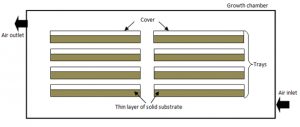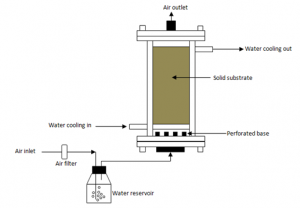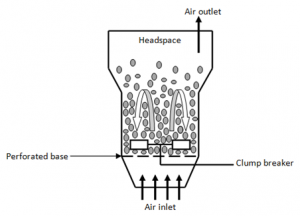Solid state fermentation
| Technology | |
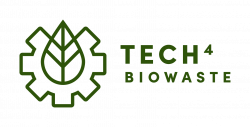
| |
| Technology details | |
| Name: | Solid state fermentation (SSF) |
| Category: | Conversion (Biochemical processes and technologies) |
| Feedstock: | Food waste, garden and park waste |
| Product: | Food products (e.g., citric acid, natto, sake, tempeh), biocides |
Solid state fermentation (SSF) is a type of fermentation with a low water content in the substrate. The solid substrate is inoculated with the culture and the cultivation is mostly performed under controlled conditions, such as controlled temperature, light and humidity. Nutrient levels, C/N ratio, feedstock-to-inoculum ratio, pH and mixing can also be controlled.[1] SSF is "a traditional cultivation technique of food technology and involves all cultivations of microorganisms on a solid substrate without free liquid phase."[1] Besides traditional food processing methods, solid state fermentation is also used for the industrial production of a diverse range of other products, such as enzymes, biogas, pigments, and antibiotics. SSF can be applied in many different fields, for example food and aroma production, production of medicines, waste treatment or environmental technology. One example of a traditional solid state fermentation is the production of Sake (a Japanese alcoholic beverage from rice). The polished and cooked rice serves as the solid substrate of the first fermentation step in the Sake production process. It is inoculated with Kōji-kin (Aspergillus oryzae) spores.[2] A. orizae is a fungus which converts the starch from the rice to sugar. After this solid state fermentation, a liquid state fermentation step follows during which yeast converts the sugar to ethanol.
Feedstock
Origin and composition
Solid state fermentation is especially suitable for the cultivation of filamentous organisms, like ascomycetes and basidiomycetes, but also for various yeasts and bacteria.[1] A diversity of microorganisms can be used for SSF and therefore a wide range of substrates can be used as feedstock.
Food products
As described above, the feedstock can be a food product, as rice or wheat bran. Another traditional food product produced by SSF is Tempeh, cooked soy beans fermented by different Rhizopus fungi. Soy beans are also fermented by Bacillus subtilis ssp. natto to create a food product called Nattō. Other substrates can also be used, as tofu dregs (okara), coconut dregs, different cooked beans and peanuts.
Agro-industrial residues
Agro-industrial residues such as cassava bagasse are for example used for the production of citric acid via SSF.[3] Citric acid is industrially produced by using the filamentous fungus Aspergillus niger. A wide range of agro-industrial residues can be used for the production of citric acid, such as apple and grape pomace, carrot waste, carob pod, orange and pineapple waste, cassava bagasse, coffee husk, kiwifruit peel, mussel processing wastes, okara (soy residue), rice and wheat bran.[3]
Waste streams
Solid-state anaerobic digestion (SS-AD) is commonly used to treat waste streams with high solid content such as municipal solid waste and lignocellulosic biomass.[1]
Other
Wood
Pre-treatment
Additives
Biochar
Heat
Cooking
Process and technologies
Solid state bioreactors
In SSF, the bioreactor provides suitable environment for microorganism growth and biological activity. Bioreactors must be able to hold the media and be sealed well which prevents harmful environment substances from entering the bioreactor. Important parameters in bioreactor design include temperature, oxygen concentration, moisture gradients as well as mixing/agitation, aeration and heat transfer. SSF bioreactor design can be classified into four groups, which can be separated by aeration and mixing type:
- Group 1: unforced aeration, without mixing/agitation (static)
- Group 2: forced aeration, without mixing (static)
- Group 3: unforced aeration, with continuous or intermittent mixing/agitation
- Group 4: forced aeration, with continuous or intermittent mixing/agitation
Group 1: Tray bioreactors
"Tray bioreactors consist of a chamber containing individual trays that can be made of different materials, such as wood, bamboo, metal, and plastic. The trays typically have open tops and perforated bottoms, and are stacked one above another with a space in between to increase the availability of air. The trays are static beds that are mixed infrequently or not at all. Air is provided into the chamber and circulated around the trays with controlled humidity and temperature."[4]
Group 2: Packed-Bed Bioreactors
"Packed-bed bioreactors are typically tubular containers that are packed with particles of substrates and microorganisms and have a perforated bottom to support the packing materials. In a packed-bed bioreactor, packing materials are generally not mixed and forced aeration is provided. The specific design of packed-bed bioreactors varies in the following aspects:
1. The cross-section of the bioreactor may have different shapes.
2. The bioreactor can be vertical, horizontal, or at an angle.
3. Aeration may be provided from either the top or the bottom. Additional aeration can be supplied by inserting a perforated tube inside the bioreactor."[4]
Group 3: Rotating drum bioreactors
Rotating drum bioreactors mix intermittently without forced aeration, operating on continuous or semi-continuous mode. A rotating drum bioreactor is a horizontal cylinder. The drum is semi-filled with a bed of substrate. The fermented bed cannot be too high and this creates good oxygen and carbon dioxide transfer. Temperature control also depends on the mixing effect of the solid substrate.
Group 4: Fluidized-bed bioreactors
Typically, fluidized-bed reactors are constructed from a vertical chamber with a perforated base plate. Forced aeration is applied at the bottom chamber at sufficient speed to fluidize the solid substrate particles and cause mixing. Also, the bioreactor has an agitator, breaking up agglomerates that can form and settle to the bottom. The bed expands and so enough headspace is needed. The mixture of solid particles and gas will behave like a liquid. The fluidized-bed bioreactor provides a good mixing behavior of gas, solid and liquids.
Products
Food products
- Citric acid[3]
- Nattō
- Sake
- Tempeh
Enzymes[5]
- Polygalacturonase
- α-Amylase
- Lipase
- Protease
- Laccase
- Cellulase
- Etc.
Lipids
Antioxidants
Biocides
Post-treatment
In order to maximize product yield, downstream strategies play an important role. The choice of downstream strategy is dependent on the type of product. For instance, if the product containts cellulase than the following downstream-based strategies can be used:[6]
- Extraction (e.g., extraction buffer in case of extracellular cellulase production)
- Purification (e.g., protein precipitation methods, chromatography and filtration)
- Crystallization (i.e., inactivation and stabilization)
Technology providers
| Company name | Country | Technology subcategory | Technology name | TRL | Capacity [kg/h] | Temperature [°C] | Feedstock: Food waste | Feedstock: Garden & park waste | Product: Food/Feed | Product: Biocides |
|---|---|---|---|---|---|---|---|---|---|---|
| Bosque Foods | - | - | - | - | - | - | ||||
| Citribel | - | - | - | - | - | - | ||||
| EsenciaFoods | Germany, Spain | - | Mycelium solid state fermentation | 4 | - | - | ● | |||
| ICSN-CNRS | France | - | Platotex | 4 | - | - |
Bosque Foods
| General information | |||
| Company: | 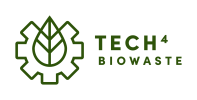
| ||
| Country: | |||
| Contact: | |||
| Webpage: | |||
| Technology and process details | |||
| Technology name: | Technology category: | Conversion (Biochemical processes and technologies) | |
| TRL: | Capacity: | kg·h-1 | |
| Atmosphere: | Nutrients: | ||
| pH: | Pressure: | bar | |
| Temperature: | °C | Other: | |
| Feedstock and product details | |||
| Feedstock: | Product: | ||
Using side streams from the Agri-food Industry allows us to upcycle low-value products into a super ingredient: Mycelium! We cultivate our pure Mycelium in unique incubators, harvest it and mix in natural ingredients and spices to turn it into our delicious whole-cuts. What’s best? This process takes less than 10 days, and can take place in an indoor vertical farming set-up, saving space, resources, and bringing it closer to you ♥On your left is a mock-up version of our process: Agricultural byproduct is mixed with water and inoculated with our Fungi (blue glitter plays the part here!). We put this mixture in our special incubator for a few days, and…Ta-da! : pure Mycelium, ready for harvest!
Citribel
| General information | |||
| Company: | 
| ||
| Country: | |||
| Contact: | |||
| Webpage: | |||
| Technology and process details | |||
| Technology name: | Technology category: | Conversion (Biochemical processes and technologies) | |
| TRL: | Capacity: | kg·h-1 | |
| Atmosphere: | Nutrients: | ||
| pH: | Pressure: | bar | |
| Temperature: | °C | Other: | |
| Feedstock and product details | |||
| Feedstock: | Product: | ||
Citribel is the only genuinely circular producer of citric acid, citrates, and other high-value co-products through natural surface fermentation of sugar molasses. Sugar molasses, the sidestreams from sugar refineries, make up the primary raw material for our unique natural production process. The molasses serve as the breeding ground for our Citribel fungus. The fungus creates citric acid and mycelium in the fermentation process. Citrates and other components are produced during further downstream processing. We recycle and upcycle our resources in a myriad of ways, generating a multitude of high-quality circular components.
EsenciaFoods
| General information | |||
| Company: | Esencia Foods | 
| |
| Country: | Germany, Berlin / Spain, Barcelona | ||
| Contact: | hello@esenciafoods.co | ||
| Webpage: | https://esenciafoods.co | ||
| Technology and process details | |||
| Technology name: | Mycelium solid state fermentation | Technology category: | Conversion (Biochemical processes and technologies) |
| TRL: | 4 | Capacity: | not relevant kg·h-1 |
| Atmosphere: | not relevant | Nutrients: | not relevant |
| pH: | not relevant | Pressure: | not relevant bar |
| Temperature: | not relevant °C | Other: | |
| Feedstock and product details | |||
| Feedstock: | to be determined | Product: | edible mycelium biomass |
Esencia Foods is Europe's first company recreating the pleasures of fish and seafood with mushroom mycelium fermentation. “My life is about food. As a scientist-chef hybridI want to go beyond creating an ‘alternative product’, but to build products that consumers crave because they are culinary highlights. We want to write a chapter in the History of Food”, says Chief Technology Officer, Bruno Scocozza. “Mycelium solid state fermentation is the perfect technology to build textures and tastes consumers love, while producing at price parity - to make a real impact.”
ICSN-CNRS
ICSN-CNRS developed a solid-state fermentation unit (called Platotex) that offers 2m(2) of cultivation surface that combines automatic sterilization, cultivation, and drying steps. Platotex is also able to support liquid-state fermentation.
| General information | |||
| Company: | ICSN-CNRS | 
| |
| Country: | France | ||
| Contact: | |||
| Webpage: | http://pilotunit.com/technologies/innovative-technology/platotex | ||
| Technology and process details | |||
| Technology name: | Platotex | Technology category: | Conversion (Biochemical processes and technologies) |
| TRL: | 4 | Capacity: | 2 M2 cultivation surface kg·h-1 |
| Atmosphere: | Nutrients: | ||
| pH: | Pressure: | bar | |
| Temperature: | °C | Other: | |
| Feedstock and product details | |||
| Feedstock: | Product: | ||
Open access pilot and demo facility providers
Patents
Currently no patents have been identified.
References
- ↑ a b c d Dr. Susanne Steudler, Dr. Anett Werner, Dr. Jay J. Cheng, 2019: Solid state fermentation : research and industrial applications. Springer International Publishing, Cham.
- ↑ Masayuki Machida, Osamu Yamada, Katsuya Gomi, 2008-8: Genomics of Aspergillus oryzae: Learning from the History of Koji Mold and Exploration of Its Future. DNA Research: An International Journal for Rapid Publication of Reports on Genes and Genomes, Vol. 15, (4), 173–183. doi: https://doi.org/10.1093/dnares/dsn020
- ↑ a b c F. C. Prado, L. P. S. Vandenberghe, A. L. Woiciechowski, J. A. Rodrígues-León, C. R. Soccol, 2005-12: Citric acid production by solid-state fermentation on a semi-pilot scale using different percentages of treated cassava bagasse. Brazilian Journal of Chemical Engineering, Vol. 22, (4), 547–555. doi: https://doi.org/10.1590/s0104-66322005000400007
- ↑ a b X. Ge, J. Vasco-Correa, Y. Li, 2017: Solid-State Fermentation Bioreactors and Fundamentals. Current Developments in Biotechnology and Bioengineering. Christian Larroche Maria Ángeles Sanromán Guocheng Du Ashok Pandey (Ed.). Elsevier, {{{place}}}.
- ↑ M.A. Lizardi-Jimenez, R. Hernandez-Martinez, 2017: Solid state fermentation (SSF): diversity of applications to valorize waste and biomass. 3Biotech, Vol. 7, (1), 44. doi: https://doi.org/10.1007/s13205-017-0692-y
- ↑ Darshan M. Rudakiya, 2019: Strategies to Improve Solid-State Fermentation Technology. New and Future Developments in Microbial Biotechnology and Bioenegineering. {{{editor}}} (Ed.). Elsevier, {{{place}}}.

